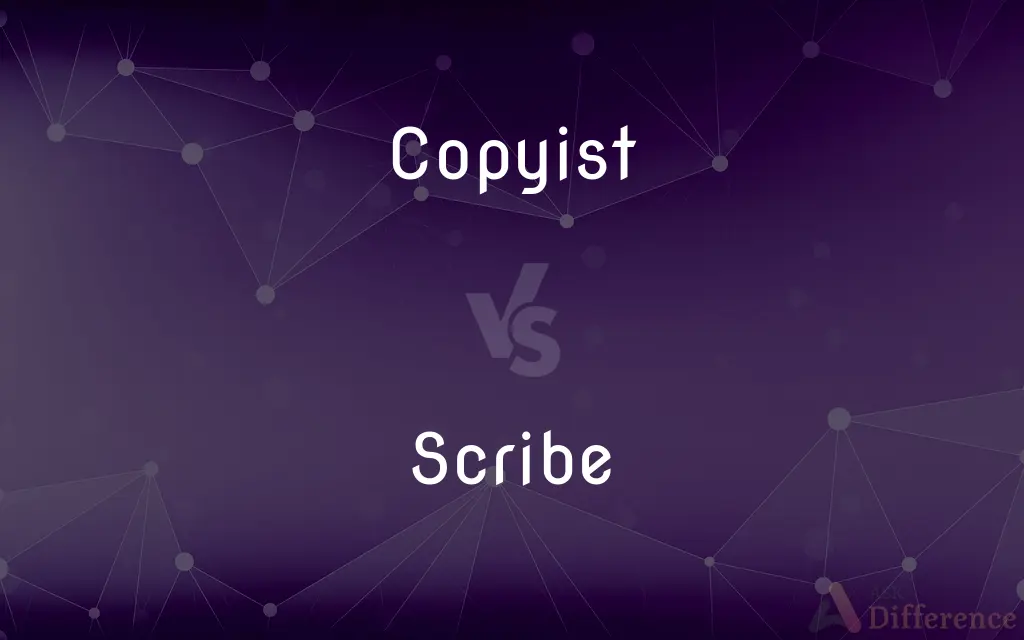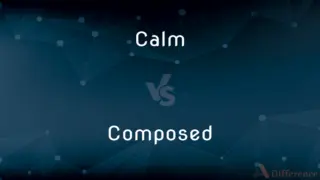Copyist vs. Scribe — What's the Difference?
By Maham Liaqat & Fiza Rafique — Updated on April 4, 2024
A copyist reproduces documents and artworks, focusing on accuracy, while a scribe records and creates original documents, emphasizing content creation.

Difference Between Copyist and Scribe
Table of Contents
ADVERTISEMENT
Key Differences
A copyist is primarily engaged in the act of copying existing documents, manuscripts, or artworks, ensuring precision and faithfulness to the original. Whereas, a scribe's role historically involved not only copying but also writing and composing original documents, ranging from legal texts to historical records, placing a greater emphasis on the creation and preservation of content.
The work of a copyist is often associated with the replication of visual materials and texts for the purpose of preservation, duplication, or artistic reproduction. On the other hand, scribes have been instrumental in the documentation of events, laws, religious texts, and administrative records, contributing to the development of writing systems and literacy.
In terms of skills, a copyist must possess a keen eye for detail, mastery over the medium (whether it be ink, paint, or digital tools), and the patience to accurately reproduce complex documents or artworks. Scribes, however, required a deep understanding of language, grammar, and context, often serving as intermediaries between the spoken and written word, translating oral traditions into written forms.
The role of copyists has evolved with technology, from manually reproducing texts and artworks to utilizing photocopying and digital scanning technologies. Scribes, historically central to the dissemination of knowledge and information, have seen their roles diminish with the advent of the printing press and, more recently, digital text creation and storage.
Despite their differences, both copyists and scribes share the common goal of preserving and transmitting information. While copyists focus on the accuracy of the form, scribes are concerned with the content and its implications for legal, religious, or historical narratives.
ADVERTISEMENT
Comparison Chart
Purpose
Reproduce existing works
Record and create documents
Focus
Accuracy and fidelity
Content creation and preservation
Skills Required
Attention to detail, mastery over medium
Language, grammar, context understanding
Role Evolution
From manual copying to digital replication
From oral tradition recorders to diminishing with technology
Main Contribution
Preservation of visual and textual fidelity
Development of writing systems, literacy
Compare with Definitions
Copyist
A person who makes copies of manuscripts or artworks.
The museum hired a skilled copyist to reproduce the ancient manuscript for display.
Scribe
A person who writes books or documents by hand as a profession.
The scribe carefully transcribed the king's decree for public posting.
Copyist
Uses various tools, from traditional pens to digital scanners.
The copyist used a high-resolution scanner to duplicate the artwork.
Scribe
Played a key role in the development of writing systems.
Ancient scribes were instrumental in creating the alphabet.
Copyist
Often involved in the duplication of legal documents.
The copyist meticulously replicated the contract for archival purposes.
Scribe
Required to understand complex linguistic and cultural contexts.
As a scribe, he translated oral traditions into written stories.
Copyist
Can work in artistic domains, copying paintings or sculptures.
As a copyist, she excels in recreating Renaissance artworks.
Scribe
Historically responsible for recording important events.
The scribe documented the outcomes of the council meeting.
Copyist
Ensures accuracy and fidelity in reproductions.
Each detail, noted by the copyist, matched the original perfectly.
Scribe
Often involved in legal and religious document creation.
The scribe drafted marriage contracts and other legal documents.
Copyist
One who makes written copies.
Scribe
A scribe is a person who serves as a professional copyist, especially one who made copies of manuscripts before the invention of automatic printing.The profession of the scribe, previously widespread across cultures, lost most of its prominence and status with the advent of the printing press. The work of scribes can involve copying manuscripts and other texts as well as secretarial and administrative duties such as the taking of dictation and keeping of business, judicial, and historical records for kings, nobles, temples, and cities.
Copyist
A copyist is a person who makes copies. The term is sometimes used for artists who make copies of other artists' paintings.
Scribe
A public clerk or secretary, especially in ancient times.
Copyist
A person who makes manual copies of works such as manuscripts or paintings.
Scribe
A professional copyist of manuscripts and documents.
Copyist
A copier; a transcriber; an imitator; a plagiarist.
Scribe
A writer or journalist.
Copyist
Someone employed to make written copies of documents and manuscripts
Scribe
See scriber.
Scribe
To mark with a scriber.
Scribe
To write or inscribe.
Scribe
To work as a scribe.
Scribe
Someone who writes; a draughtsperson; a writer for another; especially, an official or public writer; an amanuensis, secretary, notary, or copyist.
Scribe
A person who writes books or documents by hand as a profession.W
Scribe
(informal) A journalist.
Scribe
(archaic) A writer and doctor of the law; one skilled in the law and traditions; one who read and explained the law to the people.
Scribe
A very sharp, steel drawing implement used in engraving and etching, a scriber.
Scribe
To write.
Scribe
To write, engrave, or mark upon; to inscribe.
Scribe
To record, as a scribe.
Scribe
To write or draw with a scribe.
Scribe
(carpentry) To cut (something) in order to fit it closely to an irregular surface, as a baseboard to a floor which is out of level, a board to the curves of a moulding, etc.
Scribe
To score or mark with compasses or a scribing iron.
Scribe
One who writes; a draughtsman; a writer for another; especially, an offical or public writer; an amanuensis or secretary; a notary; a copyist.
Scribe
A writer and doctor of the law; one skilled in the law and traditions; one who read and explained the law to the people.
Scribe
To write, engrave, or mark upon; to inscribe.
Scribe
To cut (anything) in such a way as to fit closely to a somewhat irregular surface, as a baseboard to a floor which is out of level, a board to the curves of a molding, or the like; - so called because the workman marks, or scribes, with the compasses the line that he afterwards cuts.
Scribe
To score or mark with compasses or a scribing iron.
Scribe
To make a mark.
With the separated points of a pair of spring dividers scribe around the edge of the templet.
Scribe
French playwright (1791-1861)
Scribe
Informal terms for journalists
Scribe
Someone employed to make written copies of documents and manuscripts
Scribe
A sharp-pointed awl for marking wood or metal to be cut
Scribe
Score a line on with a pointed instrument, as in metalworking
Common Curiosities
How is a scribe different from a copyist?
A scribe is involved in creating and recording original documents, often requiring knowledge of language and context, while a copyist focuses on reproducing existing works with precision.
What skills does a copyist need?
A copyist needs a keen eye for detail, expertise in the medium of reproduction, and patience to ensure accurate replication of originals.
Why were scribes important in history?
Scribes were crucial for documenting laws, historical events, religious texts, and more, contributing significantly to the development of literacy and writing systems.
Has technology changed the roles of copyists and scribes?
Yes, technology has transformed the roles, with copyists using digital tools for replication and the traditional role of scribes diminishing due to printing and digital text creation.
What kind of documents did scribes create?
Scribes created a wide range of documents, including legal contracts, historical records, religious texts, and administrative documents.
Can a scribe be a copyist?
While scribes can perform the tasks of a copyist, their primary role historically encompassed content creation, making them distinct from copyists who specialize in replication.
Are there modern equivalents to scribes?
Modern equivalents to scribes include content creators, writers, and legal document drafters, though technology has changed the nature of their work.
What does a copyist do?
A copyist reproduces existing documents, manuscripts, or artworks, focusing on the accuracy of the reproduction.
How did scribes learn their trade?
Scribes typically learned their trade through apprenticeships, where they were taught writing, grammar, and the specific knowledge needed for their documents.
Were scribes part of a social class?
In many societies, scribes belonged to a distinct social class or professional group, often holding considerable respect and authority.
Do copyists work in the art world today?
Yes, copyists still work in the art world, reproducing artworks for study, restoration, or sale, often requiring high skill in art techniques.
What was the significance of scribes in ancient societies?
In ancient societies, scribes were vital for the administration, culture, and religion, acting as the main means of recording and transmitting knowledge.
Is copying art considered a form of artistry?
Yes, copying art can be considered a form of artistry, requiring an understanding of the original artist's techniques and intentions.
How do copyists ensure accuracy in their work?
Copyists ensure accuracy through meticulous attention to detail, using tools that help them replicate the size, color, and texture of original works.
Can anyone become a copyist?
While technically anyone can learn to copy documents or artworks, becoming a proficient copyist requires skill, patience, and attention to detail.
Share Your Discovery

Previous Comparison
Calm vs. Composed
Next Comparison
Bank vs. ShoreAuthor Spotlight
Written by
Maham LiaqatCo-written by
Fiza RafiqueFiza Rafique is a skilled content writer at AskDifference.com, where she meticulously refines and enhances written pieces. Drawing from her vast editorial expertise, Fiza ensures clarity, accuracy, and precision in every article. Passionate about language, she continually seeks to elevate the quality of content for readers worldwide.













































